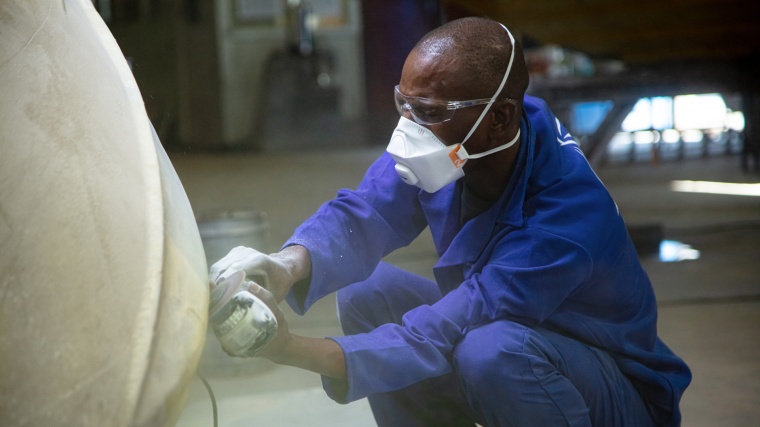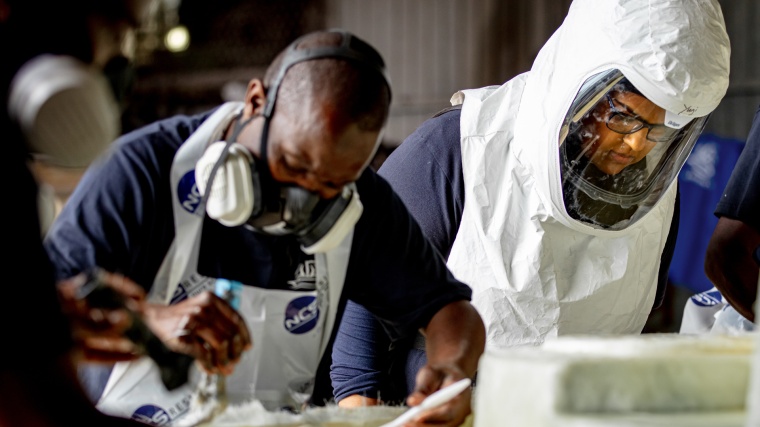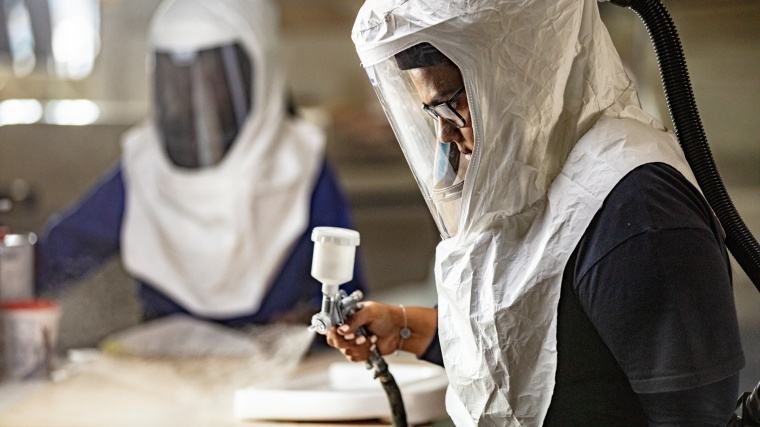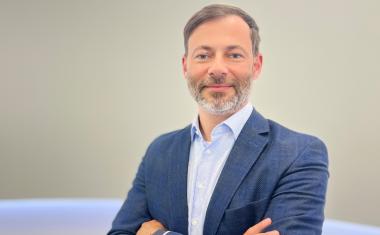Dräger Respiratory Equipment in South Africa’s Boatbuilding Industry
The company “KZN Leisure Boats” in Durban builds, repairs, and restores boats. The work with glass-fibre reinforced plastics offsets hazardous dust particles and fumes. Respiratory masks are used to protect the workers’ health.




Rays of sunlight are shining into the manufacturing hall of “KZN Leisure Boats” in the docklands of Durban harbour. Tiny dust particles are floating in the light, a smell of resin hangs in the air, grinding noises add the soundtrack. All kinds of fiberglass boats are on the floor: From recreational fishing boats to powerboats to those of South Africa’s National Sea Rescue.
Workers are busy laminating new fiberglass hulls and repairing damages. Everyone is wearing face masks to protect their lungs against the dust, says Yugeshni Naidoo, the owner of the company. “These dust particles contain fiberglass and that is really bad for the lungs. This is the air we are breathing in every day. It’s dangerous. So, we have to be masked all the time.” Especially the smaller fibres can reach the lungs, remain there, cause and aggravate respiratory diseases.
Yugeshni Naidoo is wearing a Dräger FFP2 dust mask while she checks on the progress of the work. She was using a generic brand product with ear loops before but noticed that air got in from the sides. The new masks in comparison fit perfectly and seal properly. In the past, her employees had also regularly lost masks on the floor by accident. “But with the Dräger one, you drop the quick release fastener on the back, and it hangs from your neck. So, you’ve got it the entire day and you’re safe. It sounds simple, but it helps when it comes to costs.” She now pays for one mask instead of several a day.
At first affordability was one of her main concerns, JP Dantuma recalls. He is Dräger’s regional sales manager and understands how tight the budget for many companies is in South Africa, especially in the current economic downturn. “Yugeshni is the sole owner, so she cannot go and spend thousands on PPE. Obviously, she wants the best for her staff but at the right price. This is where our products stood up against our competitors”, he says. The disposable dust masks are not the only Dräger product the 38-year-old businesswoman decided to use.
“The Safety Equipment Must Not Hinder Your Job”
In the back of the hall, four of the eleven employees are working on a new boat. The mould has been gel-coated already, now fiberglass mats and resin are applied layer by layer. They are using a low fume resin, but the smell is still strong. Luckily not for us anymore, says Maxwell Jara. He is wearing a Dräger X-plore 3500 half mask, which is renowned for its perfect seal. “As soon as I put it on, the smell is completely gone. I also noticed that I don’t have headaches anymore after a day’s work”, says Jara. Combination filters against gases and particles prevent breathing in the aggressive fumes and fibreglass dust. As soon as one starts smelling them again, it’s time to replace the filter. Jara demonstrates how easily this is done and also adds, that he feels comfortable wearing the mask all day long. “It is light and seals perfectly”.
The DrägerFlex material is soft and skin-friendly, the head strap ensures an even distribution of pressure and a solid fit. In her business comfort is not only nice to have but a necessity, Yugeshni Naidoo stresses: “Your safety equipment must not hinder your job”. She watches how her workers are applying fibreglass and resin, using laminating rollers to spread the resin evenly. “This part of the boat is very important: You have to move fast, the resin gels, which means it gets hard. So, it is crucial for them to be comfortable and able to manoeuvre easily”. The perfect, tight yet comfortable fit is also important for applications where the space is restricted, she explains further. “This mask doesn’t slip off the head. It has enough support to stay on even in the hatches”.
Fiberglass particles and resin fumes are not the only occupational health hazards in the boatbuilding industry. Grinding and spray-painting are also part of the process and expose workers to more toxic dust and fumes. They are not only detrimental for the lungs but can also cause skin rashes and inflammation of the eyes. That’s why Naidoo decided to invest in a third set of Dräger products: The X-plore 8000 series Powered Air Purifying Respirators combined with a hood worn over a bump cap thus protecting head and eyes. They are worn on a belt around the waist, automatically select the correct airflow to the hood and offer a big field of vision.
Again, it is the attention to detail which makes the design unique, says JP Dantuma. He mentions the bump cap inside the hood as an example: “If a worker has to lie underneath the boat with a spray gun and for whatever reason gets up too quickly, if he knocks his head against the hull of the boat, he will still have a bump cap to protect his head.” A long battery life is an added advantage, especially in a country like South Africa which is experiencing regular power cuts.
For Employees Dräger Masks are Simply “Life-Changing”
For employees like Michael Kambula, who has been building fiberglass boats for 25 years, these masks are simply “life-changing”. He has been suffering from tuberculosis in the past, like many South Africans, and has to take extra-care of his lungs. “These masks are really great. An acoustic signal alerts you when the filter gets clogged. The air you breathe is always fresh, clean and cool”, he says.
Especially in the hot and humid Durban summers, this is added benefit, according to Yugeshni Naidoo: “If we are laminating or gel-coating a new boat and one drop of sweat falls into the mix, it will create a bubble. So, to be cool helps.” Obviously, there shouldn’t be any bubbles in the hull of a boat, which create weak spots and could ultimately endanger the safety of the people on board. Quality and safety are essential in all aspects of this business.
In South Africa though, workers safety had long been neglected. When JP Dantuma started working for Dräger almost 22 years ago, there was no legislation around respiratory devices. “You could just sell any and everything”, he says. This changed in 2003, when a law was passed that any respiratory equipment had to be locally homologated. “Companies had six years to get their paperwork in order. Things have evolved since 2009”, explains Dantuma.
“I Still Want to Breathe Properly When I am Older”
Always, when speaking about the awareness for the health risks that boatbuilders take, Yugeshni Naidoo is reminded of her late father, who founded the company. “Back in the day, there was no safety, nothing. He used to spray-paint with no mask and no one highlighting: You’re cutting your lifespan short”. Her dad was in his mid-sixties when he passed away last year. He had been battling with his lungs for long, his daughter says. “He died of emphysema, which means he couldn’t get enough oxygen into his lungs”. She is convinced that this closely related to years of unprotected work with hazardous materials.
Occupational safety is a sensitive, personal issue for her: “I think people are lackadaisical about it. But it’s important, because I still want to be fit and breathe properly when I’m much older. So, it starts now, being masked correctly”. The same applies to her workers, she often reminds them to wear their masks. “I don’t want their job to be the reason that their health deteriorates”.
This said, she is glad, that JP Dantuma stepped into her factory one day to present the Dräger range. For him, she’s a unique client: “You have a variety of applications, a combination of different types of respiratory devices used under one roof, where for most of our clients it will be one or the other.” Yugeshni Naidoo cannot stop the offset of fumes or the fibreglass dust particles hovering in the air, but she can now make sure, that they don’t end up in her lungs and those of her workers.
Business Partner
Drägerwerk AG & Co. KGaAMoislinger Allee 53-55
23558 Lübeck
Germany
most read

Airbus Defence and Space: Security as a strategic pillar of Europe's defense capability
Airbus Defence and Space protects sites, technologies and employees with modern security and cyber solutions - strengthening Europe's resilience in uncertain times

The Benefits of AI-based Video Surveillance Solutions for Sports Venues
Dallmeier Interview: Artificial intelligence Makes Stadiums Smarter

Is Your Venue Ready for Martyn’s Law?
Martyn’s Law demands stronger security by 2027. Is your venue prepared to protect and respond?

GIT SECURITY AWARD 2026 - The winners have been announced!
GIT SECURITY AWARD 2026: The best safety and security solutions of the year - now an overview of all winners

Assa Abloy's battery-powered Aperio KL100 secures lockers
Boost workplace security and operational flexibility by securing more than just doors.








